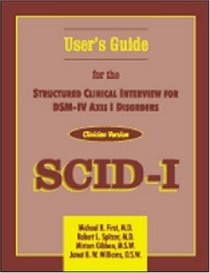Search -
User's Guide for the Structured Clinical Interview for Dsm-IV Axis I Disorders: Scid-1 Clinician Version
User's Guide for the Structured Clinical Interview for Dsm-IV Axis I Disorders Scid-1 Clinician Version
Author:
Designed by the pioneers of structured interviewing, the Structured Clinical Interview for DSM-IV Axis I Disorders-Clinician Version (SCID-I) makes the benefits of structured interviewing available to the clinician for the first time. This efficient, user-friendly instrument will help clinicians make standardized, reliable, and accurate diagnose... more »
Author:
Designed by the pioneers of structured interviewing, the Structured Clinical Interview for DSM-IV Axis I Disorders-Clinician Version (SCID-I) makes the benefits of structured interviewing available to the clinician for the first time. This efficient, user-friendly instrument will help clinicians make standardized, reliable, and accurate diagnose... more »
ISBN-13: 9780880489317
ISBN-10: 0880489316
Publication Date: 1/1997
Pages: 132
Rating: ?
ISBN-10: 0880489316
Publication Date: 1/1997
Pages: 132
Rating: ?
0 stars, based on 0 rating
Publisher: American Psychiatric Association
Book Type: Paperback
Members Wishing: 0
Reviews: Amazon | Write a Review
Book Type: Paperback
Members Wishing: 0
Reviews: Amazon | Write a Review
Genres:
- Health, Fitness & Dieting >> Psychology & Counseling >> Clinical Psychology
- Health, Fitness & Dieting >> Psychology & Counseling >> General
- Health, Fitness & Dieting >> Psychology & Counseling >> Pathologies
- Health, Fitness & Dieting >> Psychology & Counseling >> Reference
- Health, Fitness & Dieting >> Psychology & Counseling >> Testing & Measurement
- Medicine >> Specialties >> Psychiatry >> General
- Medical Books >> Medicine >> Internal Medicine >> Psychiatry




